Final report for FNC16-1046
Project Information
Our group of Oneida Community members called Ohe.laku - Among the Corn Stalks grew 3 acres of Heirloom White Corn using the conventional method of tilling the field. We hired an agronomist who took soil samples and identified the nutrients our soil would need to grow healthy corn. We ordered organic fertilizer from United Co-op and broadcast the pellets and 15 loads of aged horse manure with a manure spreader. We borrowed the Oneida Apple Orchards corn planter and planted on May 25, 2018. We applied the fish emulsion three times during the growing season. Before receiving this grant we did not grow corn as a group on a shared field. We were backyard gardeners. Some folks decided to grow in their back yards and with the larger group. We encourage this for many reasons. If our large field should fail the back yard gardeners would still have corn to eat. If the back yard garden failed or pests destroyed the entire plot the gardeners would still have corn. Growing in many areas increases seed diversity, food security and food sovereignty. It also provides an opportunity to do small test plots of the benefits of fish emulsion.
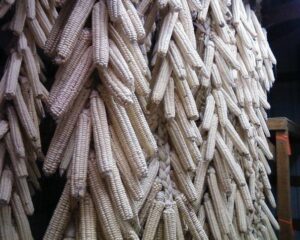

This is the corn that was not sprayed with fish emulsion in the 4H field in 2018. As you can see it is stunted, not completely pollinated or developed.
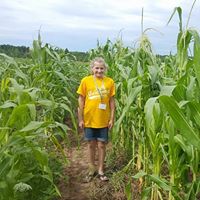
2016 our first year growing corn together. It did not get much taller than 6 feet.
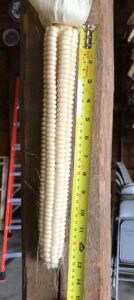
This was our longest cob in 2017. Even with all the rain we got some nice cobs. Weeding really helped.
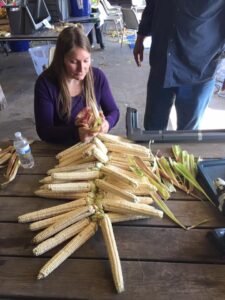
This is a braid we are saving for seed to plant again next year.
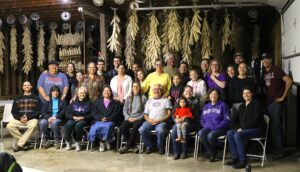
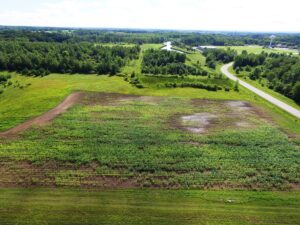
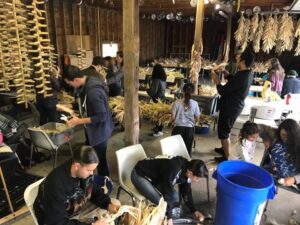
WORK ACTIVITIES
We started our grant with a meeting attended by Lea Zeise, Regional Representative for the Intertribal Agriculture Council; Joanie Buckley, Division Director Internal Services Oneida Tribe; Bill Vervoort, Coordinator-Integrated Food Systems Oneida Tribe; and myself, Laura Manthe, Coordinator for the Oneida White Corn Growers. The meeting outcomes were a commitment of the use of a 13 acre field that was being leased from the Oneida Tribe by the Oneida 4-H Chapter, the printing and mailing of a postcard to the head of household of all Oneida in Brown and Outagamie Counties inviting them to a meeting titled “White Corn & Soil Health”, printing the ad in the Oneida newspaper the Kalihwisaks, and free use of a meeting room at Ridgeview Plaza also owned by the Oneida Tribe.
Initially, in the grant application, we planned for Tony Kuchma to present at this meeting. But Tony felt that a professional would be better suited for this event. We contacted Val Dantoin, Instructor of Organic Agriculture at Northeast Wisconsin Tech College. She agreed to present at the meeting. 48 people attended the meeting. Most of them were there to learn about their own backyard garden soil health and had no interest in growing White Corn. Val conducted a pre -test and a post-test to gauge the participant’s knowledge of how to take a proper soil sample. She gave a lecture with a slide show on how to take a soil sample, organic fertilizers, and ways to build up the health of soil. After a potluck lunch, those who were interested in growing White Corn stayed for a meeting where Laura discussed the very recent and fast moving events that led up to 25 people committing to discussing further the opportunity to grow White Corn together.
Back Yard growers who were identified in the SARE Grant application received a binder with a copy of the grant, expectations for participants, baggies to put the soil samples in and envelopes for mailing to AgSource Labs, a language CD to play when working with the corn and a list of Upcoming Events including a next meeting date of April 9, 2016.
It was clear after the initial meeting, that most people interested in growing White Corn did not have access to land and would not fit the Back Yard Growers we identified in the SARE Grant Application. A decision was made to have two groups of growers. The first would be the Ohe.laku group or Among the Corn Stalks group that would grow on the 13 acre 4-H site and the other would be the Back Yard Growers. Some participants were in both groups. Not everyone had seed corn to plant so we decided to pool our corn and grow 3.5 acres of corn as a test to see if we could work together, to see if we could build a better relationship with the corn and our cultural knowledge, and to learn how to use the Fish Emulsion to fertilize the plants.
We started our growing season with a Tobacco Ceremony at the 4-H site. We planted 11 pounds of seed per acre on May 21, 2016 with a corn planter we borrowed from the Oneida Apple Orchard. The children participated by picking rocks in the field, planting squash around the edges of the field, weeding and singing to the corn. We continued our group planting on a different area in the same field on May 29, 2017 and May 25, 2018.
We met every month in 2016, 2017 and 2018. Two of our participants are certified TOPs Facilitators. They kept the meetings focused so we could identify what White Corn Victory would look like at the end of the growing season, our Strengths and Weaknesses as a group, and created a Commitment Contract for everyone to sign. Laura and Robin found a 500 gallon sprayer at the FFA Auction in Seymour, WI for $500. A friend who is an electrician wired the sprayer to Robin’s tractor. The sprayer was filled with water and a 5 gallon pail of Fish Emulsion was added. This was done three times during the growing season in 2016, one time in 2017 and three times in 2018. Some of the participants learned how to operate the tractor and sprayer, the tractor and planter, the cultivating tractor, and some brought rototillers from home to keep the weeds at bay.
Laura also purchased a 30 gallon sprayer for the Back Yard Growers. She gave them 1 gallon jugs of Fish Emulsion and asked them to keep track of the amount used and the times it was applied. At harvest time, they were to measure the amount of seed to soup grade corn they harvested. Becky Webster planted 300 seeds in her backyard in May of 2016 and harvested 150 corn cobs in October. That came out to 3 pounds of seed grade and 45 pounds of soup grade corn. Eliza Skenandore planted Zuni Blue Corn instead of Iroquois White Corn and had similar results as Becky in 2016 and 2017. She was amazed at the physical difference between the corn that was sprayed and corn that was not. Both families felt bad about not fertilizing all of the corn plants. They felt like they were mistreating the corn but the lesson they learned about the value of Fish Emulsion was firmly etched in their minds. Keith Metoxen used the 30 gallon sprayer and the Fish Emulsion in his backyard. He lost all of his corn to raccoons in 2016. He is convinced the raccoons liked the Fish Emulsion smell. Randy Cornelius planted his seeds in late June and his corn did not have enough time to reach maturity. He planted again in 2017 and 2018 with great results.
2016 Harvest results for Rebecca Webster, Backyard plot
During the summer months, participants were encouraged to stop out at the 4-H corn field and uncover the small corn stalks after the cultivating tractor went through, weed as needed and sing to the corn plants.
Ohe.laku started picking the 3.5 acre field on Sunday, September, 18, 2016 and wrapped up on Sunday, October 16, 2016. We started picking on Sunday, Sept 30, 2017 and finished on Oct 15, 2017. We started picking on Sept 15, 2018 and finished on October 15, 2018. One hundred ninety braids of corn were hung from the rafters in the rented barn in 2016, two hundred and fifty in 2017 and 439 in 2018. Six 8 foot x 4 foot screen racks were built to hold the corn that lost its husk and was unable to be braided, and long sticks with screws were built to attach corn cobs to dry and two 8 foot x 4 foot fine screen racks were built for individual kernels from the cobs that only had a few kernels. Laura used the moisture meter to test the corn kernels moisture level. When they reached 11 percent or lower the corn was put in glass jars for storage. The hanging weight of the corn braids on Monday, January, 2, 2017 was 1520 pounds. The hanging weight of the corn braids on Saturday, February 10, 2018 was 2030 pounds. That amount was divided by the participants and handed out for them to hand shell at home. It is estimated that each participant will have 60 pounds of shelled soup grade corn, and 5 pounds of seed grade corn will be replanted on the 4-H field in May 2017 and May 2018. In October of 2018 we had fifteen seed braids hanging.
We feel we met our definition of Victory that we identified on April, 12, 2016 by re-establishing our relationship to the corn, learning new skills, trusting each other, creating a big pile of corn with the help of the Fish Emulsion, learning the language, building family, building community, participating in Ceremony, reaching out to our relatives in New York and Canada for advice and mentoring, sharing our corn with indigenous people from Ecuador, Mexico and US.
RESULTS TO DATE
The Back Yard Growers were able to clearly demonstrate the benefits of the application of the Fish Emulsion. They had side-by-side corn stalks that were sprayed and not sprayed. The corn stalks that were sprayed were tall, dark green, and had huge corn cobs on them. The corn stalks that were not sprayed were spindly, light green, small skinny corn cobs that did not yield any corn. They took pictures of the corn during the growing season and posted them on the group Facebook Page.
The 4-H site was more difficult to demonstrate because of the varying soil types in the field and the condition of the soil. Where the Fish Emulsion was sprayed and the soil was dryer the corn was very abundant. Where the soil was wetter and the Fish Emulsion was sprayed the corn did not yield. Overall, everyone who participated was convinced that the Fish Emulsion was the determining factor in the health of the corn stalks and size of the corn cobs.
The participants were interviewed on December 18, 2016. They were asked what they learned from the project. Some answers were:
“I would compare growing corn to pregnancy. I knew things were coming but I didn’t know what.”
“I learned so much from the Onondaga Tribe being here at the Braiding the Sacred Event. It gave me the confidence I needed to harvest the 3.5 acre field.”
“Next year the corn will be treated like a second kid.”
“Learning about corn, about our history opened my eyes.”
“I’m excited by what we started here. I want to make a pie chart for my kitchen so I can track how much White Corn I can incorporate into my diet.”
“This was a very positive group – everyone worked on solutions to problems.”
“I want to process the corn and use it year round. I loved the fellowship and positive way we worked together. Learning about the corn was not work for me. I lost track of time. It takes a village to grow a field.”
“I got to spend more time with my family and we did community building. I did this for my son who is three years old. He knows where the field is. He wanted to visit it every time we drove close to it. I got to share cultural knowledge with the group and see it come alive. Corn soup is not just for special occasions.”
WORK PLAN
All of the participants from the 2016 season plan to participate in the 2017 season. We figured out a way to include more participants in the group. Each original member or sponsor will be allowed to invite one person into the group under their wing. If the new person or winger does not work out, the group will tell the sponsor and it is the sponsor's responsibility to inform the winger that they are not a good fit for the group. If the winger does work out for the season the group votes in January to make them a full member, keep them as a winger or vote to deny full membership. The sponsor also shares their corn harvest with the winger. Once the winger is a full member they can bring someone else in under their wing.
We also figured out a way to hand weed the field without overwhelming the participants. We created a system of row assignments to identify the start and stop point in the three acre field. Giving each other the responsibility of caring for a few rows and keeping an eye on each other's rows if they look neglected.
Our first Planning Meeting will be in March of each year. We will discuss the work plan for the next growing season and pool the corn they shelled at home until we reach 33 pounds of seed. We will set the May planting dates for the 4-H field. Laura will continue to coordinate and manage the project. We will start the discussion for the travel the first or second week of May for Outreach with the Iroquois White Corn Project at Ganondagan in Victor, New York; meeting the Seneca White Corn Growers in Allegany, New York; and visiting the Onondaga Reservation to help them hand plant 15 acres of White Corn each year. We will continue to measure the amount of Fish Emulsion applied to the corn and measure our yield. Some of the Back Yard Growers have decided to expand their garden areas and try to grow more white corn along with other varieties of Iroquois corn to expand our traditional diets.
OUTREACH
We created two Facebook pages. One to communicate with the Ohe.laku group and the Back Yard Growers and the other to share our story with others who may be interested in learning more about our journey. Communication was essential during the growing season as weather and stages of corn growth determined the work that had to be completed.
A few articles were published in the Oneida newspaper Kalihwisaks. Twenty students from Northwestern University in Evanston, Ill joined us for a hands-on demonstration on October 8, 2016. The students also returned on October 21, 2017 and October 5, 2018. We also hosted an event called “Braiding the Sacred” from September 30 to October 2, 2016 and October 6 to 8, 2017 and Harvest Moon on October 19 to 21, 2018. Many Native Americans from around the Great Lakes gathered to talk about the importance of corn in indigenous culture and to help us hand harvest our crop.
Community group bonds over growing white corn article, Kalihwisaks, 10-20-16
Kali-Article-April-2018-Ohe.laku-goes-to-Ecuador
We will continue to do Community Outreach on a Thursday at the Oneida Farmers Market where we will be selling samples of our White Corn in a traditional soup. We have also set aside a full share of corn to donate to the Community during their time of need at funeral meals. We felt that was the best way to share our harvest and fulfill our responsibility to each other.
**************************************************************************
WORK ACTIVITIES
We followed the same process to plant the corn as we did in 2016. One new thing we decided to try was row assignments for each participant so we could manage the weeds better. Last year we would ask participants to weed the field but they felt overwhelmed and could not keep up with the weeds. We were scolded by our older brothers from the Onondaga Nation in New York for not taking care of the weeds. They attended our first Braiding the Scared event and they said our yield was impacted by the amount of weeds taking nutrients from the corn plants and hampering pollination. They invited us to their reservation near Syracuse, NY to learn how to hand plant 15 acres of white corn. We traveled to New York in May 2017 and May 2018 and spent a few days working in their fields, learning about their seed bank and attending the Seed Ceremony at their longhouse. The experience enlightened us and gave us the confidence to plant a large area by hand and to maintain it. All of the hard work of weeding between the rows and between the corn plants paid off. Our yield was beautiful and the quality of the corn was obvious.
RESULTS TO DATE
In 2017 we were not able to use the 500 gallon sprayer in the shared field because of the wet weather; some of the Back Yard growers were able to. Randy Cornelius reported that he got some monster cobs and this was the best crop ever in all of the years he has been growing. He used a watering can to apply the fish emulsion three times during the growing season. Once when they are seedlings and 2 weeks later and again 3 weeks later. He used 1 teaspoon of fish emulsion per gallon of water. He planted 16 rows of 25 hills each with 3 corn seeds. He did not lose any to raccoons or deer as a dog was used to keep the animals away. The wind did blow the corn down but it stood itself back up again without any help. Randy used a rototiller to keep the weeds suppressed and hand weeded the hills. He harvested 640 cobs. He eats white corn twice a week in chili and corn soup. He is very glad he was able to participate.
The other back yard growers did not have the same success. Laura Cornelius felt the soil was depleted as they grew corn on the same spot for three years. Her corn yield was very low compared to the first year. Eliza Skenandore did not plant corn this season because she went back to college. Rebecca Webster planted a purple corn in 2017 but it did not grow. In 2018 she planted a wampum corn and the yield was disappointing. She did not do a soil test and will follow the protocols we set in place for all future plantings.
Our estimate is 1,500 pounds of corn for 2016, 2,500 pounds for 2017 and 4,000 pounds for 2018.
WORK PLAN FOR 2018
We will continue to grow corn as a group in the shared field in 2018. We will plant 3 rows for each participant as we learned through trial and error that three 100 foot rows was the maximum amount of corn people could hand weed between the corn stalks. We will continue to use the fish emulsion to add the necessary nutrients to the corn plants when it is needed most. We will also continue our outreach efforts to share the information we have learned.
OUTREACH
We shared our corn at the Oneida Farmers Market reaching 100 people in 2016, 2017 and 2018. Rebecca Webster and her daughters spoke about their experience growing corn in their back yard as well as with the larger group at the Women, Food & Ag Network (WFAN) Conference in Madison, WI in November 2017. We hosted the Braiding the Sacred in Oct 2016 with 52 participants, in 2017 with 43 participants and 2018 with 39 participants. Robin and I also got married in the corn field and had a working wedding reception with 55 guests helping with the harvest in 2017. Our guests were so glad they were invited to participate. They learned so much from the event and they want to be invited back again next year to help. We will make harvest a community event from now on.
In 2018 we also gave tours of our corn field and slide show presentations to Professors from the Iowa State University, UW Oshkosh, UW Whitewater, Northwestern University, Green Bay Public School System, the Sustainable Agriculture and Natural Resources Conference in Duluth, MN with 30 participants, the Feast of Nations at UW Green Bay with 75 participants and Sam's Club Corporate Employees with 35 participants. We also hosted the Sustainable Farming Systems of Oaxaca, Mexico at our barn with 40 participants.
Six Oneida farmers (referred to as Project Farmers) aim to measure the costs and benefits of using traditional fertilizer and modern equipment to grow white corn. The approach is to first improve their understanding of soil science through workshops, soil sampling and analysis with the help of Tony Kuchma, The Soil Guy, in Oneida. The Project Farmers will purchase a 60-gallon trailer mount sprayer to apply fish emulsion as an iteration of our traditional practice of burying fish waste in mounds of soil and planting corn, beans, and squash on top. Project Farmers and youth can use the hand sprayer feature on smaller plots, and it can be attached to Laura’s cultivator tractor for larger plots. Farmers will keep consistent records of costs, labor, and yield of both seed and food-grade corn at 11% moisture content on forms developed by Lea Zeise.
Project Farmers will investigate trading seed with other Iroquois farmers in New York and selling raw, shelled corn to Oneida Cannery for processing and sale on the Oneida reservation. With data showing production cost, yield of dry white corn, Cannery purchasing needs and price per pound.
We will also distribute corn song CDs so farmers can play traditional songs while they work in the fields until they learn them well enough to sing them. Laura Cornelius, an Oneida elder and language expert, will develop a language game that can be played with community youth, whom, as always, we will continue to involve in the planting, fertilizing, harvesting, husking, and, of course, enjoying the meals of the corn. Outreach events will include seed sharing and story telling to preserve the language and stories and to address the genetic diversity threat.
**************************************************************************
Each monthly meeting starts with introductions of the participants in the Oneida Language. This practice has increased the amount of language we speak and the words we added to our vocabulary. It also reminds us to have a good mind when were are discussing agenda items. We share food at our meetings and have come up with three new recipes using the white corn.
The back yard gardeners had a tough time with the excessive rain as well. Raccoons did major damage on all of the white corn fields. This was very disheartening to the growers. We decided we need to learn how to eat raccoon.
In 2017, we tracked the hours spend on the project by self reporting our hours on our private face book page. We reported 2000 hours of work to produce 4000 pounds of corn. Because of the labor intensiveness of growing, weeding, hand harvesting, hand husking and hand braiding the corn we decided that we can not sell the corn for any amount of money. We are instead re establishing the trade routes with other native people across North America.
Cooperators
Research
Educational & Outreach Activities
Participation Summary:
I gave tours of the corn field during the growing season to various University Professors, IPM reps and other Tribal Representatives who were interested in community based farming. I gave a talk at the Indigenous Food Summit in Oneida, Wisconsin in October. We also brought corn to the conference site and set up a hands on display for conference participants to learn how to husk and braid the white corn. Rebecca Webster was a speaker at the Women, Food & Ag Network (WFAN) Conference in Madison, Wisconsin in November. She presented a slide show highlighting the Fish Emulsion data results she collected and her experience with the larger community group of corn growers. I presented a slide show at the Intertribal Agriculture Conference in Las Vegas, Nevada in December.
We communicated our results at the Indigenous Food Summit in Connecticut August, 2018 and the Braiding the Sacred in September, 2018.
In 2018 we also gave tours of our corn field and slide show presentations to Professors from the Iowa State University, UW Oshkosh, UW Whitewater, Northwestern University, Green Bay Public School System, the Sustainable Agriculture and Natural Resources Conference in Duluth, MN with 30 participants, the Feast of Nations at UW Green Bay with 75 participants and Sam’s Club Corporate Employees with 35 participants. We also hosted the Sustainable Farming Systems of Oaxaca, Mexico at our barn with 40 participants.